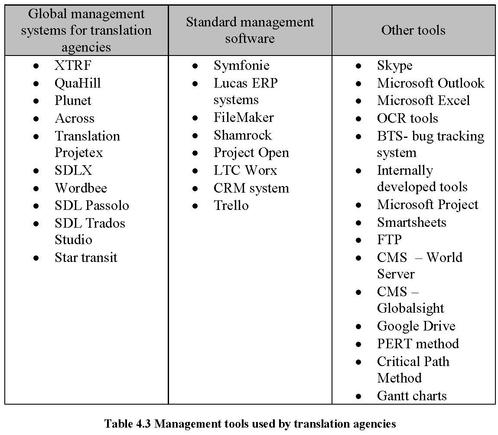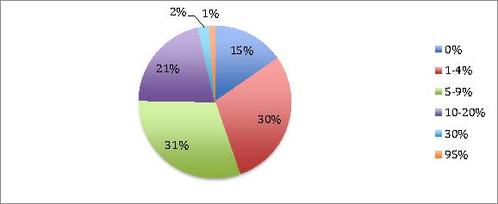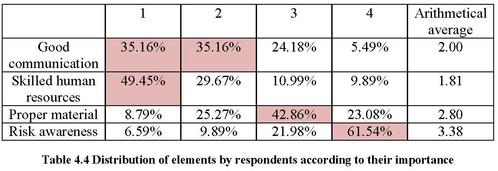SURVEY RESULTS: Risk Management in Translation Projects
PART 2 - PROJECT MANAGEMENT IN TRANSLATION PROJECTS
Question 1: What types of projects are assigned to you?
To answer this question the respondents could chose multiple answers from among documentation, web, software and/or multimedia; and they could insert another element or comment in the Other box. Figure 1 reveals that TPMs most frequently deal with document-type projects. In the Other box, the respondents added some details about the type of localization projects they handle such as marketing, videogames, voice-over, books but also SEO activities (search engine optimization) and terminology creation. All in all, the results reveal that there is clearly significant demand for documentation-type translations.

Figure 4.1 Average percentage of demands per type of project
Question2: What type of management tool(s) do you use?
This is an open question and the answers are numerous and varied; the type of answers vary depending on the type of translation company. Small-scale companies most often resort to basic management tools such as templates created internally, Microsoft Outlook and Microsoft Excel; or even simply pen and paper. Medium and large companies also resort to the same basic management tools, but in addition they use management software (purchased or developed internally). Table 4.3 summarizes the management tools in three different categories: translation management systems, standard management software and other communication and management tools.

Question 3: Ideally, a project has to meet the quality requirement and has to be
delivered to the client on time and on budget. If you could respect only one
of these conditions, whatever the reason, which one would it be?
Participants had the choice between quality, deadline, and budget; they could also add another element or comment. As depicted in figure 4.2, most of the participants consider quality to be the most important condition to respect, followed by deadline and budget. In the Other box, participants added: good communication with the client, confidentiality (security) and regulatory compliance. The other answers in this box are additional comments regarding their choice.
The purpose of this question is to set out the most important objective(s) of a project’s success. Indeed, knowing which objective is the most important to reach – and which one can eventually be sacrificed – facilitates the risk prioritization during the plan risk response phase. However, some respondents insist on the inseparable nature of these three conditions and that it makes no sense picking just one.
Moreover, some respondents give priority to the deadline because they believe it is vital for the client. Others defend that quality is a priority if deadline can be negotiated. Finally, most of them seem to agree that it depends on the nature of the project.

Figure 4.2 Average percentage of prioritization per project objective
Question 4: Which one of the following conditions do you most often fail to respect?
In the same vein as the previous question, the respondents could choose between quality, deadline and/or budget or could add another element or comment in the Other box. The results shown in figure 4.3 reveal that TPMs most often fail to respect the budget condition, followed by deadline and quality.

Figure 4.3 Average percentage of failure per project objective
A great number of participants added their comments, shared their opinion or justified their choice in the Other box. As depicted in figure 4.3, the area of failure is quite different from one respondent to another. In one quarter of the comments, the respondents add that all the conditions have to be respected and failing only one of them could have a serious impact on the project. Conversely, a majority of the respondents commented that they never fail one of these conditions or insist that it is very occasional; allegedly they always deliver the highest quality, respect deadlines and stick to the budget. Some of them explain that this absence of failure is due to the fact that the objectives are clearly stated with the client and the team at the start of the project; if the client requirements cannot be met, they do not take the job. Some admit that they sometimes have to sacrifice or renegotiate the deadline with the client because the project scope has changed, issues have arisen, or there are a lot of queries; consequently a deadline extension allows better quality to be achieved. This corresponds to the results of the previous question where most TPMs gave priority to quality to the detriment of budget and deadline. Moreover, as respondents defend, deadlines are always flexible while budget and quality are usually not. On the other hand, other TPMs admit they sometimes sacrifice quality because it is a subjective condition and they know they will have the occasion to correct it after the client’s feedback. Regarding the budget, some say that if a quote changes after the kickoff it will pose a great risk to the project. However, others say that budget sometimes has to suffer in order to meet customer satisfaction.
Question 5: What is the approximate percentage of ‘failure’ of your translation projects?
(Failure stands here for a project that was not delivered on time, on budget or
that did not meet quality requirements)
The results depicted in figure 4.4 reveal that about 15% of the TPMs have a minimum failure rate (0%). The smallest failure rate ranges from 1 to 9% and concerns 61% of the TPMs. This is followed by a failure rate situated between 10 and 20% and concerns 21% of the PMs. Finally, 2% of the TPMs admit that 30% of the project objectives are not met and 1% of the TPMs admit that they experience about 95% of failure on their projects.

Figure 4.4 Average percentage of failure rates on projects
Question 6(a): The following elements make up a good project.
Classify them from 1 to 4 according to their importance.
(1-most important; 4-least important)
The number of answers for each element has been converted into a percentage in table 4.4 in order to calculate the arithmetical average of the classification. On each line, the largest percentage has been highlighted for a better overview at a glance. Based on the average, respondents classify the elements as follows: (1) skilled human resources, (2) good communication, (3) proper material and (4) risk awareness.

Question 6(b): Would you add another element? If so, which one?
In the comments, respondents generally point out that the elements taken separately seem easy to handle but that the secret of a successful project really lies in the art of juggling all of them simultaneously. Regarding good communication, many of them seem to agree that clearly defined roles, responsibilities and deadlines are vital. Additionally, some respondents suggest adding another element: client management; they consider it an art rather than a science. Indeed, it is important to enquire about the client’s expectations and relevant project information. Concerning the human resources (translator, reviser, etc.), one respondent believes that they indeed have to be skilled but more importantly, they have to be available at the right time. As for the proper material, some respondents seem to agree that the quality of the source text is of utmost importance. Last, but not least, one respondent explains that although it is indeed important to be aware of the possible risks a project may encounter, it is even more important for a TPM to possess problem-solving skills.
Part 3: Risk Management in Translation Projects >
(< Back to Part 1: General Information)
